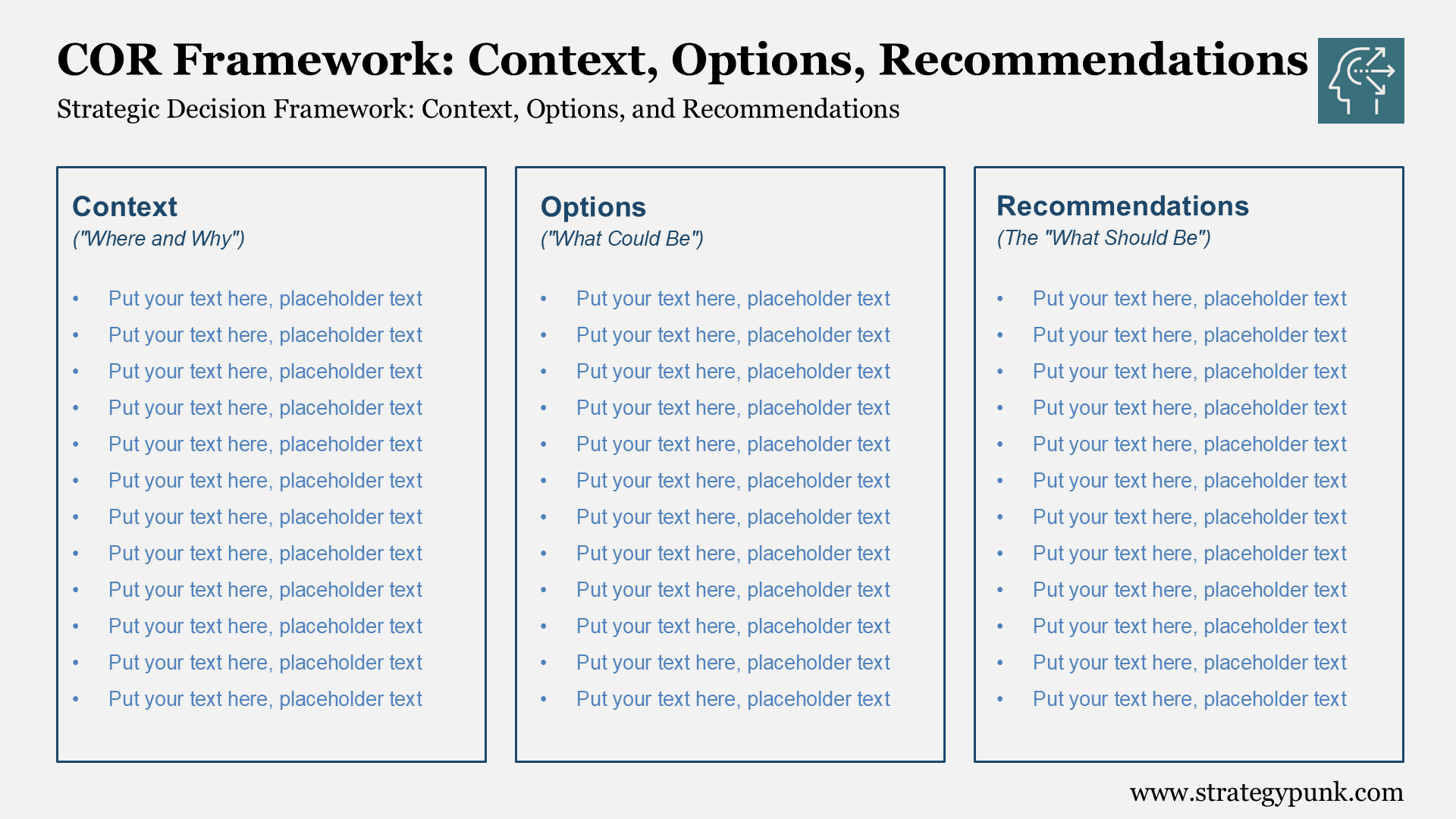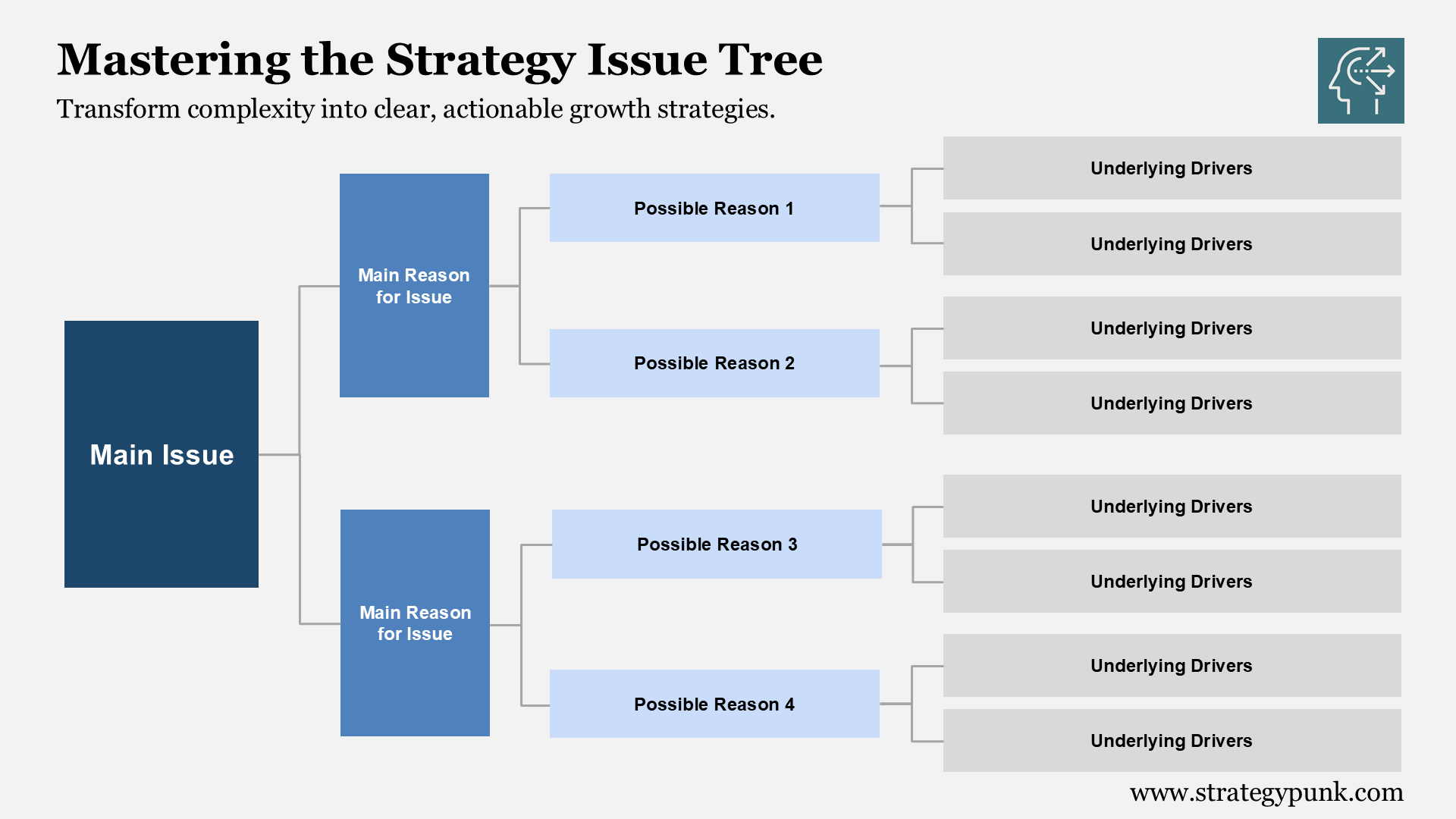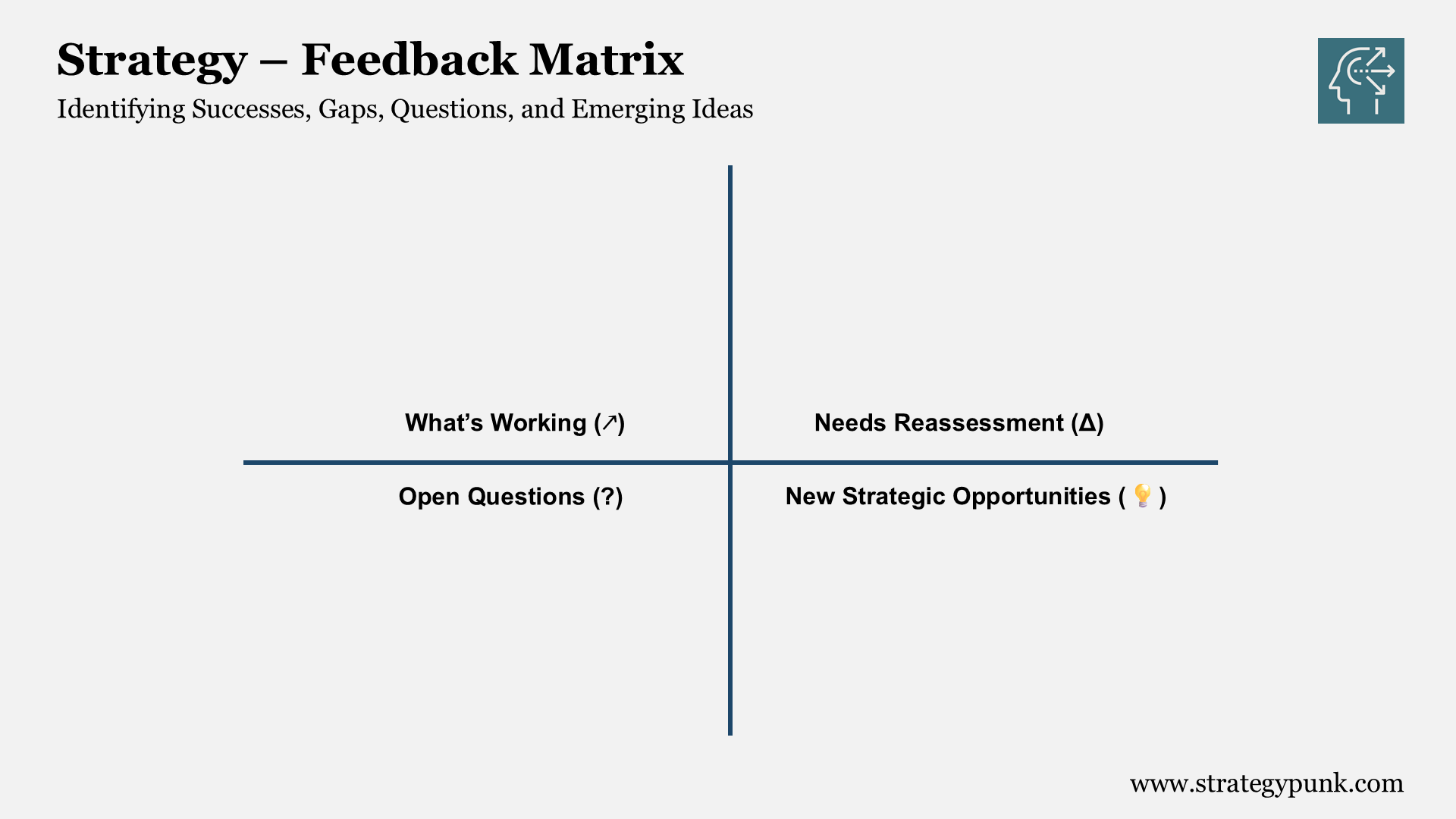Leadership - 5 dysfunctions of a team: PowerPoint Template
Introduction and Workshop template to Patrick Lencioni's 5 dysfunctions of a team
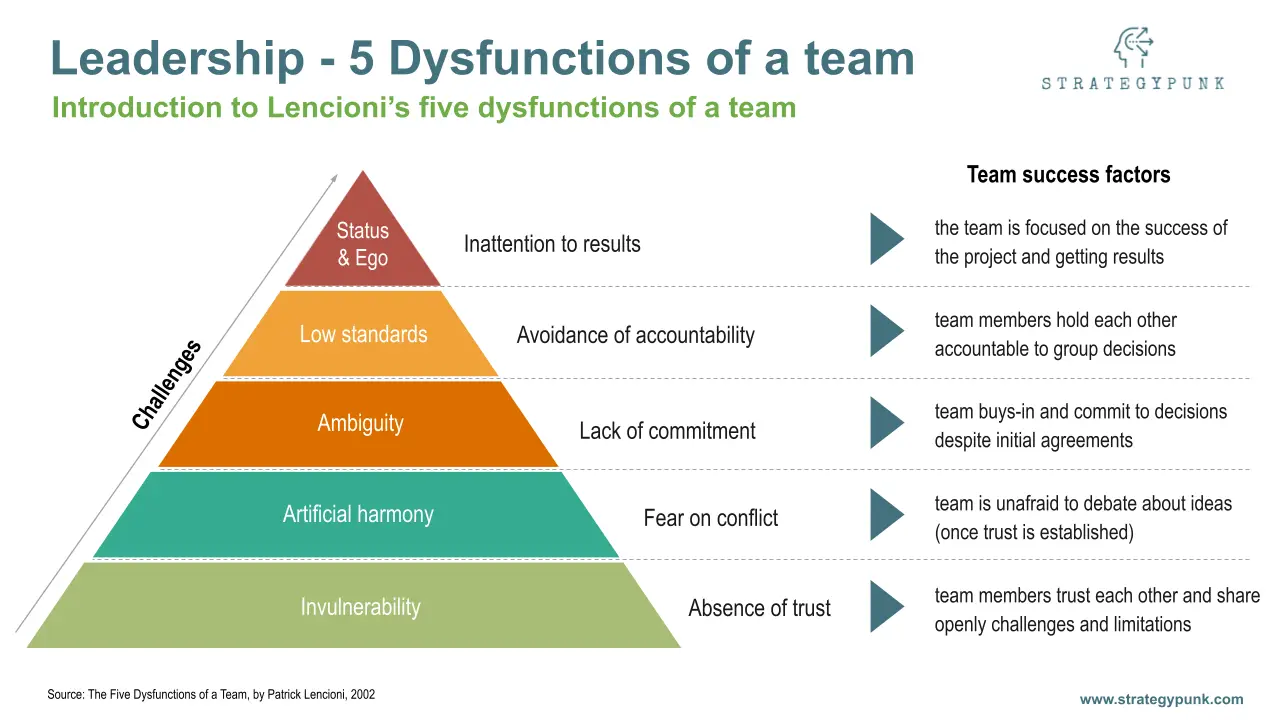
Introduction
Dive into our comprehensive guide on Patrick Lencioni's renowned "Five Dysfunctions of a Team."
We've included a free PowerPoint template to make your learning journey smoother. This guide is simple, concise, and designed with care. It is tailored for those eager to enhance team dynamics.
Let's get started!
The Five Dysfunctions of a Team by Patrick Lencioni: A Concise Overview
Patrick Lencioni's "5 dysfunctions of a team" is a definitive guide in organizational health.
His leadership fable, centered around CEO Kathryn Petersen and DecisionTech, a Silicon Valley company, offers practical information on team development.
This section aims to provide a concise and authoritative overview of Lencioni's five dysfunctions model, emphasizing its core principles and implications for executive consulting.
Absence of Trust
Trust forms the bedrock of any healthy team. Lencioni says that trust is necessary for team members to avoid vulnerability, which hinders open communication and teamwork.
Building trust requires time, consistent behavior, and transparency. An online assessment or team survey can help gauge this level.
Fear of Conflict
Teams that lack trust often avoid interpersonal discomfort, leading to preventing conflict. However, Lencioni also points out that healthy, productive competition is essential for growth.
Avoiding conflict can be a pitfall, causing teams to miss opportunities. Healthy debate fosters innovation and ensures all perspectives are considered.
Lack of Commitment
Team members need healthy ideological conflict to feel invested in the decisions made, leading to a need for more buy-in. Commitment isn't about consensus but clarity.
Teams, especially an executive team, must be clear about their direction and priorities. A team field guide or team video can help reinforce this commitment.
Avoidance of Accountability
When there's a lack of commitment, team performance often suffers. Team members hesitate to call out peers on behaviors and performance that might hurt the team. High standards of performance and conduct are crucial.
Effective teams, like those in management consulting firms, hold one another accountable, recognizing that it's a way to uphold these high standards and achieve shared goals.
Inattention to Results
The pinnacle dysfunction is when teams prioritize individual goals over collective results. Such a poor team might need help to meet deadlines, as members focus on personal recognition.
Successful teams, like those in a high-performing executive team, focus on the collective goal, ensuring individual efforts align with the team's mission.
Wrapping Up
Lencioni's model, often called the "dysfunctions of a team model," is the definitive source for building teams. By recognizing and addressing these dysfunctions, teams can foster trust, embrace productive conflict, commit to shared goals, hold each other accountable, and stay focused on results.
Making the team functional and cohesive requires courage and discipline, which many groups might find challenging.
However, with the right management skills and offsite facilitation, teams can avoid discussing the wrong issues and revisiting the same topics. Instead, they can set an example, row in the same direction, and achieve their objectives in an ever-evolving business landscape.
Lencioni's five dysfunctions of a team outline the causes of team dysfunctionality and what to be done to overcome each cause. It is a well-known model by Patrick Lencioni that many leaders refer to. The most effective way for a leader to tackle all five team dysfunctions is to lead by example and be a positive role model - every day.
The slide deck consists of 6 PowerPoint Slides - 1 slide with the introduction of the model and five additional workshop slides on each dysfunction. The workshop templates are designed to have an open and honest conversation with your team on possible shortcomings and to address each of the dysfunctions most teams struggle with.
As we have all worked in good but also, many times, not-so-good teams, each team member's choice to help build an environment you want to work in each day. The template lets you find a path to a well-functioning and successful team.
5 dysfunctions of a team assessment
Several assessment tools can be used to measure a team's five dysfunctions. One such tool is the Five Dysfunctions of a Team Assessment, which is based on Patrick Lencioni's model and designed to help teams identify their strengths and areas for improvement.
The assessment consists of a series of questions that team members answer individually. Then, the results are compiled and discussed as a team.
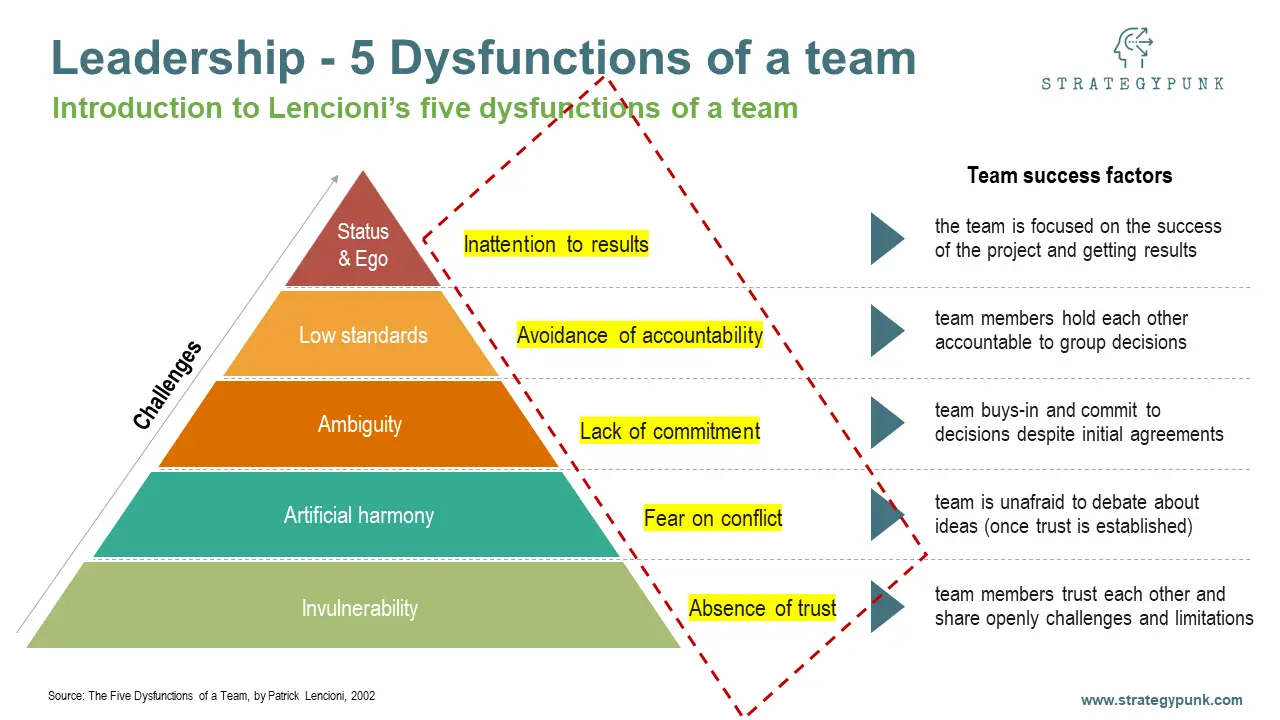
The assessment measures the following five dimensions:
- Inattention to results: The team focuses on collective success and achieving results.
- Avoidance of accountability: the level of individual and collective accountability within the team
- Lack of commitment: the extent to which team members are aligned on goals and decisions
- Fean on conflict: the level of healthy debate and disagreement among team members
- Absence of trust: the degree to which team members feel comfortable being vulnerable and open with one another
The assessment can identify areas where the team is performing well and areas where it can improve.
It can also be used as a starting point for team development activities and discussions to address any identified dysfunctions.
FAQ
Frequently Asked Questions
What are the 5 dysfunctions of a team?
The five dysfunctions of a team, as identified by Patrick Lencioni in his 2002 published book The Five Dysfunctions of a Team, are:
- Inattention to results: The team is more focused on personal success and status than the team's success.
- Avoidance of accountability: Team members are not held responsible for their actions and do not hold each other accountable for their commitments.
- Lack of commitment: Team members must be fully invested in the team's decisions, which can lead to confusion and a lack of follow-through on action items.
- Fear of conflict: Team members feel unsafe expressing their opinions and ideas, leading to a lack of healthy debate and decision-making.
- Absence each team member's choice to help build an environment you want to work in each day to have the best intentions.
These dysfunctions can lead to a toxic team culture and ultimately hinder the team's ability to achieve its goals.
What are practical strategies to overcome the five dysfunctions of a team?
Here are some practical strategies to overcome the five dysfunctions of a team:
1. Build Trust
- Leaders should demonstrate vulnerability first to establish openness and honesty. Share personal stories, admit mistakes, and ask for feedback.
- Encourage team members to share personal details and find common interests. Organize informal team events outside of work.
- Follow through consistently on promises and commitments. Trust is built over time through reliability.
- Address any lingering tensions, conflicts, or grudges openly and head-on. These undermine trust.
2. Engage in Conflict
- Establish team norms that conflict can be healthy and is encouraged in the spirit of finding the best ideas.
- Actively seek out dissenting views during discussions. Thank team members for challenging perspectives.
- Remind people that conflict surfaces the best ideas and avoids groupthink. Reframe it as productive debate.
- Diffuse tension with humor. And take breaks if discussions get heated.
3. Commit to Decisions
- Once a decision is made, all must get behind it, even if there is still disagreement. Avoid re-litigating.
- Discuss what it looks like to disagree but commit. Outline expected behaviors.
- Note that conflict and debate happen first, then clear decisions are made, allowing the team to move forward.
4. Hold Each Other Accountable
- Establish clear expectations and metrics for success. Document roles and responsibilities.
- Conduct regular check-ins on deliverables, goals, and team health.
- Address performance issues quickly, directly, and factually. Do not avoid difficult conversations.
- Reward and recognize achievements tied to team goals. Peer recognition can be robust.
5. Focus on Results
- Define success metrics clearly. Establish a few Wildly Important Goals the team wants to achieve.
- Celebrate small wins and milestones, not just end goals. Recognize collective and individual progress.
- Discuss what works well and what can be improved after projects are finished. Focus on continuous improvement.
- Remember that team results are more important than individual egos and interests.
Overcoming the five dysfunctions requires openness, communication, constructive conflict, accountability, and a shared commitment to team success. It starts with establishing trust and ultimately leads to a results-focused focus.
Five dysfunctions of a team executive summary
There are five primary dysfunctions that teams commonly struggle with:
- Inattention to results → focus on achieving collective results
- Avoidance of accountability → hold each other accountable to deliver on plans
- Lack of commitment → commit to action after having reached a collective agreement on a goal
- Fear of conflict → engage in an unfiltered conflict
- Absence of trust → Build trust, the main building block of the pyramid, as trust is the foundation of teamwork



